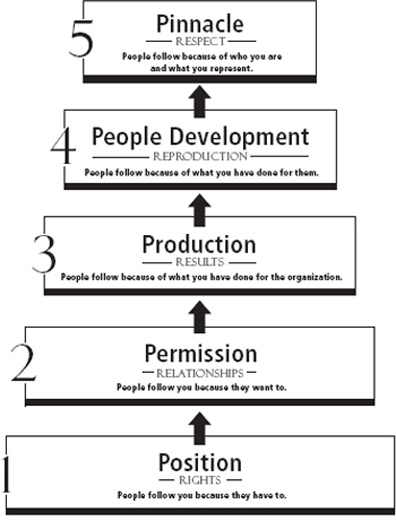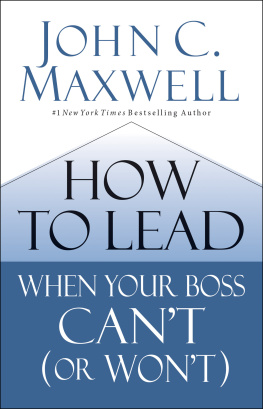
In accordance with the U.S. Copyright Act of 1976, the scanning, uploading, and electronic sharing of any part of this book without the permission of the publisher constitute unlawful piracy and theft of the authors intellectual property. If you would like to use material from the book (other than for review purposes), prior written permission must be obtained by contacting the publisher at permissions@hbgusa.com. Thank you for your support of the authors rights.
This book is dedicated to EQUIP (www.iequip.org) and all the
people who are a part of this leadership organization.
EQUIPs Rule of 5:
Every day we
Think Globally
Evaluate Our Leadership Strategy
Create Resources
Develop Associate Trainers, Partners, and Donors
Train Leaders to Train Leaders
Millions of leaders are being trained
because of your efforts. Thanks!
Thank you to:
Charlie Wetzel, my writer;
Stephanie Wetzel, my social media manager;
Linda Eggers, my executive assistant;
And of course, Fluffer Nutter.
I f your vision of success includes starting an organization, owning a company, or putting together a team, you need to become good at leadership. If you cannot lead well, you will not be successful.
When I discovered this, leadership became one of my passions. I love learning about it. I also enjoy teaching it. Ive dedicated more than thirty years of my life to helping others learn what I know about leading. In fact, I spend about eighty days every year teaching leadership. In the last several years, Ive taught it on six continents. The subject is inexhaustible. Why? Because everything rises and falls on leadership. If you want to make a positive impact on the world, learning to lead better will help you do it.
In all the years that Ive taught leadership, there has been one lecture that I have been asked to give more often than any otherfrom West Point to Microsoft headquarters and in countries all around the world. Why is it so popular? That lecture explains how successful people lead and provides a game plan for learning how to become a leader. Its titled The 5 Levels of Leadership, and it has been used to train leaders in companies of every size and configuration, from small businesses to Fortune 100 companies. It has been used to help nonprofit organizations understand how to lead volunteers. And taught in more than 120 countries around the world. The concept is tested and proven. It also instructs people in the use of several tried-and-true techniques that will help them become successful at leadership.
Looking at leadership as a series of levels that can be gained through targeted actions has many benefits. Here are just a few:
It Creates a Clear Picture of Leadership
For those who are not naturally gifted at it, leadership can be a mystery. For them, leading people is like walking down a dark corridor. They have a sense of where they want to go, but they cant see ahead and they dont know where the problems and pitfalls are going to lie. For many people in the academic world, leadership is a theoretical exercise, an equation whose variables are worthy of research, study, and rigorous debate. In contrast, the 5 Levels of Leadership is visually straightforward, so anyone can learn it.
It Defines Leading as a Verb, Not a Noun
Leadership is a process, not a position. There was a time when people used the terms leadership and management interchangeably. I think most people now recognize that there is a significant difference between the two. Management is at its best when things stay the same.
Leadership deals with people and their dynamics, which are continually changing. The challenge of leadership is to create change and facilitate growth. Those conditions require movement, which, as you will soon see, is inherent in moving up from one level of leadership to the next.
It Breaks Down Leading into
Understandable Steps
The subject of leadership can be overwhelming and confusing. Where does leadership start? What should we do first? What processes should we use? How can we gain influence with others? How can we develop a productive team? How do we help followers become leaders in their own right? The 5 Levels of Leadership gives answers to these questions using understandable steps.
It Provides a Clear Game Plan for
Leadership Development
Too often when people think of their journey into leadership, they envision a career path. What they should be thinking about is their own leadership development! Good leadership isnt about advancing yourself. Its about advancing your team. The 5 Levels of Leadership provides clear steps for leadership growth. Lead people well and help members of your team to become effective leaders, and a successful career path is almost guaranteed.
It Aligns Leadership Practices,
Principles, and Values
When I developed the 5 Levels, I conceived of each level as a practice that could be used to lead more effectively. As time went by and I used and taught the levels, I realized they were actually principles. Heres the difference: a practice is an action that may work in one situation but not necessarily in another. A principle is an external truth that is as reliable as a physical law. For example, when Solomon said, A gentle answer turns away wrath, but a harsh word stirs up anger, he stated a principle that is universal and timeless. Principles are important because they function as a map, allowing us to make wise decisions. If we embrace a principle and internalize it, it becomes a part of our values. The 5 Levels influences my leadership life every day.
H ow do people learn leadership? For most, its through trial and error. While some things come only through experience, I believe the framework for how leadership works can be learned by looking at the 5 Levels. So lets start with an overview and a few insights about the Levels and how they work. Then we can look at each level individually in the subsequent sections of this book. As you look at each level, you will learn the upside, downside, and best behaviors for that level. You will also become acquainted with the beliefs that help a leader move up to the next level.
Level 1Position
People follow you because they have to.
Position is the lowest level of leadershipthe entry level. The only influence a positional leader has is that which comes with the job title. Positional leadership is based on the rights granted by the position and title. Nothing is wrong with having a leadership position. Everything is wrong with using position to get people to follow you. Position is a poor substitute for influence.

Overview of the 5 Levels of Leadership
People who make it only to Level 1 may be bosses, but they are never leaders. They have subordinates, not team members. They rely on rules, regulations, policies, and organization charts to control their people. Their people will only follow them within the stated boundaries of their authority. And their people will usually do only what is required of them. When positional leaders ask for extra effort or time, they rarely get it.
Positional leaders usually have difficulty working with volunteers, younger people, and the highly educated. Why? Because positional leaders have no influence, and these types of people tend to be more independent.
Next page














